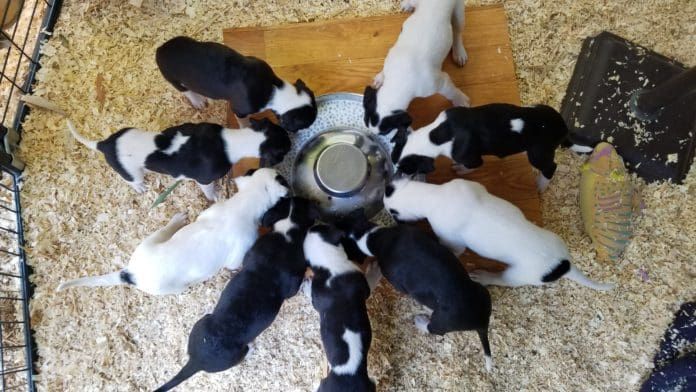As I measure out their medicine (to treat their coccidia infection), wipe their faces and paws after meals, and pick up more of the endless supply of loose poop the puppies leave in their wake, I often find myself wondering how to get people in my community to prevent their dogs from so frequently reproducing.
I live in a low-income rural town in a low-income rural county in far northern California. It’s only about three hours from the affluent communities in the San Francisco Bay area, but it may as well be an entirely different country, for all the differences in how dogs are commonly kept and treated here.

When I lived in the Bay area, I took my dogs to a holistic veterinarian who used both conventional medicine and acupuncture, chiropractic, and herbs. There was any number of force-free trainers, dog walkers, dog daycare providers, and boarding facilities to choose from. Most dogs lived with their families indoors. And most were either altered (spayed or neutered) or assiduously managed to prevent unwanted reproduction. And finding adoptable puppies in shelters is actually difficult – when a litter is made available, they all get adopted within hours.
In contrast, where I live now, it seems like there is just an ENDLESS supply of puppies washing onto the shores of my local shelter, which serves both my smallish town as well as all of the unincorporated areas in the county.

While I am fostering this litter of 10 pit/shepherd-mix pups, there is another litter of 10 pit-mix pups, about five weeks older than my crew, just going up for adoption, as well as a litter of five Kelpie/Border Collie-mix pups and another dozen puppies from three or four other, smaller litters.
Part of the problem here is that there is a perceived shortage of low-cost spay/neuter clinics in the county. I say “perceived” because each time I have made appointments at these clinics (once for a sweet “community cat” in my neighborhood, and once for the dog who belongs to the community college student who rents a room in my office/house), I found the price to be exceedingly reasonable and was able to make the appointment the same week; the clinics were not so booked that it took a month to get a surgery appointment, as can often be the case in more-populated areas with more demand. And yet I have heard people who were surrendering intact animals (or these ubiquitous litters of unwanted puppies) to the shelter complain about their lack of access to low-cost spay/neuter. I think it’s just a euphemism for “not free” and “a tiny bit inconvenient.”

I think the greater problem is a lack of education and incentive to either control/contain their dogs or make a spay/neuter appointment – or to adopt an already-altered animal from the shelter! People who buy or accept a “free puppy” hardly ever seem to manage to get their animals altered before puppies are imminent.
I once heard someone on a community radio show discussing her local shelter’s tactic for trying to increase the rate of spay/neuter in her area: The shelter had a monthly drawing for a cash prize; I think it was about $250! Entry to the drawing was free, and the pool of potential winners was fairly small: only people who could submit a receipt for their pet’s spay or neuter surgery from the previous month could enter.
The shelter provided all the local veterinary clinics with posters that publicized the monthly drawing and tried to encourage veterinarians to help spread the word that some lucky owner could win back the cost of the surgery. I have long wanted to try something similar at my local shelter, and am sure I will try it sometime. Perhaps I’ll even sponsor the cash prize – when I’m not breaking my own monthly budget paying for foster-puppy food and medicine.
What about your area? Do you know of any other good ideas for promoting higher rates of spay/neuter, or helping people prevent their intact dogs from having “accidental” litters of puppies? I’d love to hear about anything that works.







There’s the carrot method, which you suggested.
I would ask around at churches, public places, libraries, or youth events and establish some education workshops. (possibly schools, if it’s well-received that way first) Kids are more responsive to animal suffering than culturally-programmed-and-hardened adults. At best, you can encourage them to nag their parents about it, and possibly get more done, and at worst, you at least have a next-generation of pet owners who will do right.
There’s also a stick method: take pictures of all the dead animals at the shelters and paper the town with flyers.
There’s the reduce, reuse, recycle method: If there’s a deer processing place nearby, get the animals processed into the fertilizers bonemeal and bloodmeal (for gardens)- and offer it as a fundraiser for the shelter.
If you have a LOT of guts, get dogmeat sausage made- and as a black humor thing, bill it as cat food, and vice versa. (eating same-species meat, I think, causes problems)